Here’s my list of the best granular effect plugins you can find as a sound designer, both in terms of synthesis and effects.
If there’s one thing I’ve learned in my years of obsessing over sound design, it’s that granular synths and effects have the potential to transform a track from meh to whoa. For the uninitiated, granular effects is like taking a sound file, shattering it into a billion tiny pieces (called grains), and then rearranging, stretching, warping, or mangling them into something beautifully chaotic or hauntingly ethereal.
It’s like giving your audio the superpower to travel through time, space, and an alternate dimension all at once. Whether it’s turning a piano into a shimmering alien choir or a drum loop into a glitchy, interstellar breakdown, granular effects, and synths let you bend reality in ways no other tool can. And honestly, what’s not to love about that?
I think every producer and audio engineer needs a little granular madness in their toolkit. Why? Because these tools bring personality, and I’m talking big, bold, unapologetic personality. They’re unpredictable and otherworldly, which is exactly what you want when you’re tired of cookie-cutter presets and tracks that sound like they’ve been churned out of the same factory.
Take a listen to artists like Jon Hopkins, who weaves granular textures into his cinematic and electronic productions, or Aphex Twin, who uses it to summon alien-like soundscapes. Even mainstream producers like Flume and Bonobo have dipped their toes into this world, using granular tools to craft lush, unique sound environments that hit you right in the feels.
That’s why I put together this list of the best granular effect plugins you can get your hands on in 2025. I’ve tried and tested them all (yes, I spent way too many hours tweaking knobs and losing track of time), and these are the ones I keep coming back to.
1. Lese Glow
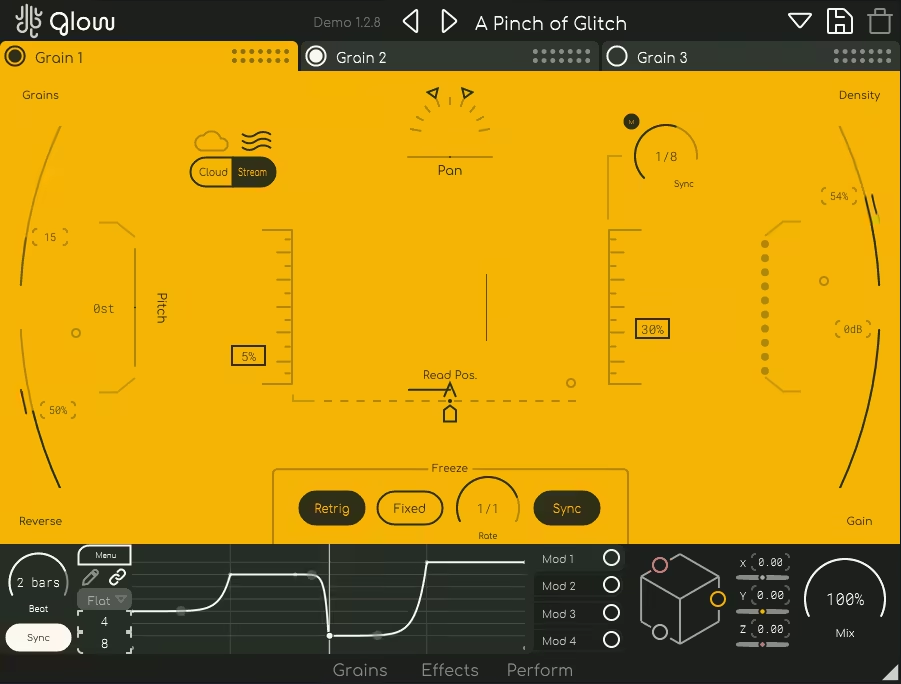
First up on this list is Glow, granular synth plugin that takes the phrase “shatter your sound” to a whole new level of creativity.
I think Glow’s granular engines are like tiny audio surgeons, made for cutting, splicing, reversing, and warping your sounds into a fragmented wonderland. Think of it as taking your audio on a rollercoaster ride through something like a “particle accelerator,” and when it comes out the other side, it’s… entirely something else!
Glow essentially features 3 granular engines working together like some kind of sound-design Avengers team.
- Granular Jazz
Each engine can handle up to 50 grains at once, which means you’re looking at a jaw-dropping 150 simultaneous grains when all engines are fired up. This “mass granulation” creates textures that range from subtle, shimmering atmospheres to dense, chaotic soundscapes that sound like they came straight from the soundtrack of a sci-fi epic.
You can use that to turn a boring pad into a galactic choir or a dull drum loop into a glitchy avalanche of rhythm.
- Complicated yet Streamlined Workflow
In my opinion, the controls are an audio nerd’s dream. Glow’s interface looks like it was pulled straight from a fighter jet cockpit, with HUD-style sliders and knobs that let you tweak pitch, pan, density, reverse probability, and more.
The Stream Mode is perfect for more traditional granular processing, but the real star is Cloud Mode.
Here, you can stack those 50 grains per engine into a swirling, overlapping storm of sound, which is perfect for creating lush, otherworldly soundscapes or pseudo-reverbs so detailed they could stand alone as the lead in a mix.
- Incredible Modulations
And let’s talk modulation for a second. Glow doesn’t just give you basic LFOs or envelope followers. Want to craft a bizarre, zigzagging modulation shape? You can draw it by hand, snap it to a grid, or tweak curves until they’re just right.
Glow’s 4 modulators are endlessly customizable, making it feel less like a plugin and more like an artist’s toolkit.
The cherry on top for me is the multidimensional “Macro Cube,” which lets you control multiple parameters at once, making live tweaking an absolute blast.
I love that I can assign 3 parameters to different dimensions of the cube and then let your creativity fly. It’s expressive, intuitive, and just plain fun.
Glow also has a freeze feature that’s ridiculously versatile. Whether you’re manually freezing audio, retriggering it at set intervals, or even sidechaining the retrigger to external audio (yes, really), Glow makes it easy to take a single moment of sound and stretch it into infinity.
Lese Glow is available in VST3, AU, and AAX plugin formats and is compatible with both Windows and Mac operating systems.
2. BLEASS Granulizer
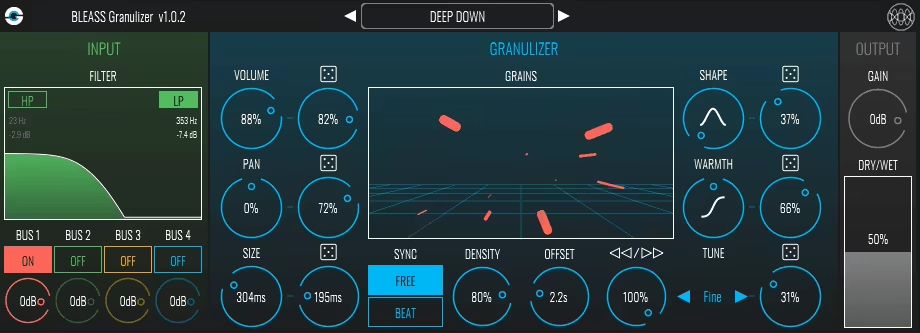
BLEASS Granulizer is a dedicated granular effects processor that can make your sounds sound like they are sprinkled with a heavy dose of “intergalactic pixie dust.”
It’s as if your sounds are being shredded into tiny pieces, reorganized, and sprinkled back together in ways you never expected. Its interface is clean and intuitive and perfect for tweaking things on the fly.
Right off the bat, I saw controls for grain size, density, and panning. When I played with these, I could easily create anything from shimmering ambient washes to glitchy, chaotic textures in seconds.
- Chaos and Control
One feature I particularly love is the ability to randomize parameters like grain size, panning, and volume. This adds a level of unpredictability to your sound design, creating textures that feel alive and constantly evolving. The app even lets you sync grain size and density to your DAW’s tempo, making it suitable for rhythmic effects like arpeggiated chords or complex, glitchy sequences.
- Turn everything huge and wide
Oh, and speaking of chords, one of Granulizer’s standout tricks is its ability to generate pseudo-polyphony from monophonic sounds. Feed it a single clarinet note, and suddenly, you’ve got this lush, harmonized pad that sounds like it belongs in a film score.
- Color your sounds
I enjoyed that the plugin also allows you to control grain direction (forward or reverse) and offset, which can act as a delay-like effect.
You can also add a touch of distortion, and you’ve got a sound that’s gritty and textured. Further, Granulizer’s multi-bus setup lets you route multiple audio sources into it, randomly selecting grains from different inputs and blending them together.
Imagine taking four completely different sound sources (like radio static, a vocal sample, a synth pad, and a drum loop) and letting the plugin mix and match tiny pieces of each.
BLEASS Granulizer is available in AU and VST plugin formats and is compatible with Windows 8 and later and macOS 10.9 and later operating systems.
3. Arturia Efx FRAGMENTS
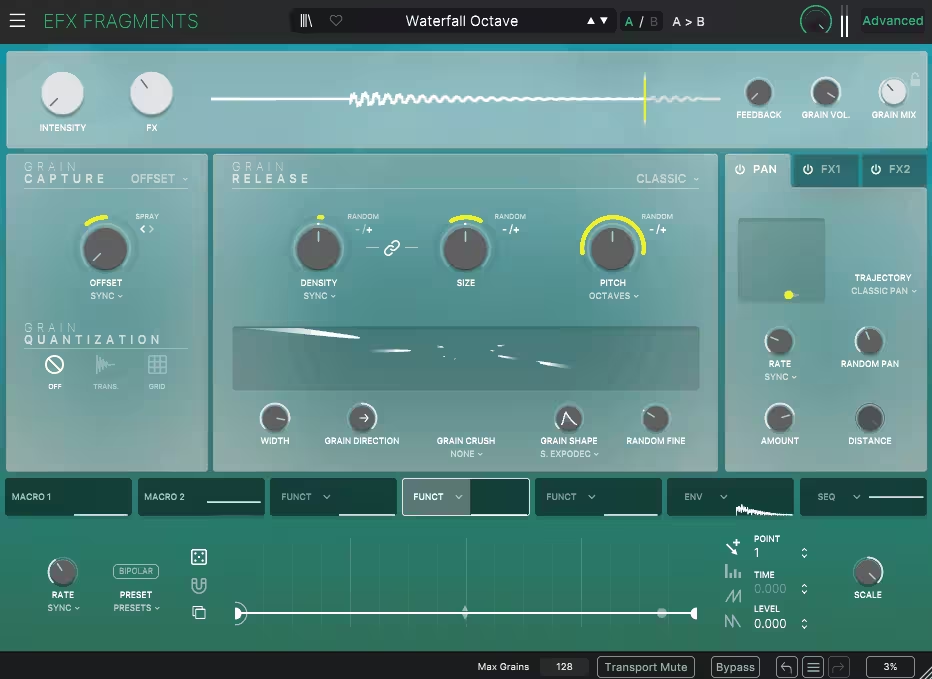
RAGMENTS delivers the mind-bending power of granular effects while keeping things accessible, musical, and fun.
At the heart of Efx FRAGMENTS is its granular effect engine, which deconstructs incoming audio in real-time and allows you to play with grain density, size, and pitch.
Its visual interface gives you a real-time look at how your sound is being dissected and rearranged, with a waveform display that feels more like a science experiment than an audio tool.
- Different Granulization Modes
-
- Classic Mode lets you create rhythmic textures, shimmering drones, or lush pads. It’s perfect for turning a simple audio snippet into a sprawling, atmospheric masterpiece.
- Texture Mode takes those grains and weaves them into continuous soundscapes. Think flowing, ethereal layers that could soundtrack a sci-fi epic.
- Rhythmic Mode is where the real fun begins for beatmakers, and it slices and dices your audio to create glitchy grooves and intricate rhythmic layers that sync beautifully to your track’s tempo.
- A mix of beauty and chaos
FRAGMENTS can add subtle sparkle to a vocal or completely destroy a drum loop, leaving it sounding like it got chewed up by a robot and spat out as some glorious, glitchy madness.
But I like the Advanced Panel more, which gives you fine-grain control (literally), with options like randomization, pitch quantization, and even a sequencer for rhythmic effects.
- Visual Interface
When watching FRAGMENTS in action I felt like watching an abstract art piece come to life.
The waveform display shows your audio being split into grains in real-time, with colorful markers that dance as you tweak parameters like grain size, density, and direction.
You can randomize pretty much anything, whether pitch, length, playback direction. The results range from haunting drones to playful glitches to sounds you didn’t know were possible.
- FX section
Built-in panning, delay, reverb, and distortion let you shape your sound even further.
My favorite was advanced panner, which makes grains move dynamically across the stereo field and adds this spatial, almost hypnotic motion to your mix. Combine that with granular reverb or a touch of distortion, and you’ve got sounds that feel alive and evolving.
All things considered, I think this one deserves a special place in our best granular effect plugins list with its high versatility. You can also check other Arturia effect units here to accompany this one.
Arturia Efx FRAGMENTS is available in VST3, AU, and AAX plugin formats and is compatible with both Windows 10 or later and MacOS 11+ operating systems.
4. Audio Damage Quanta 2
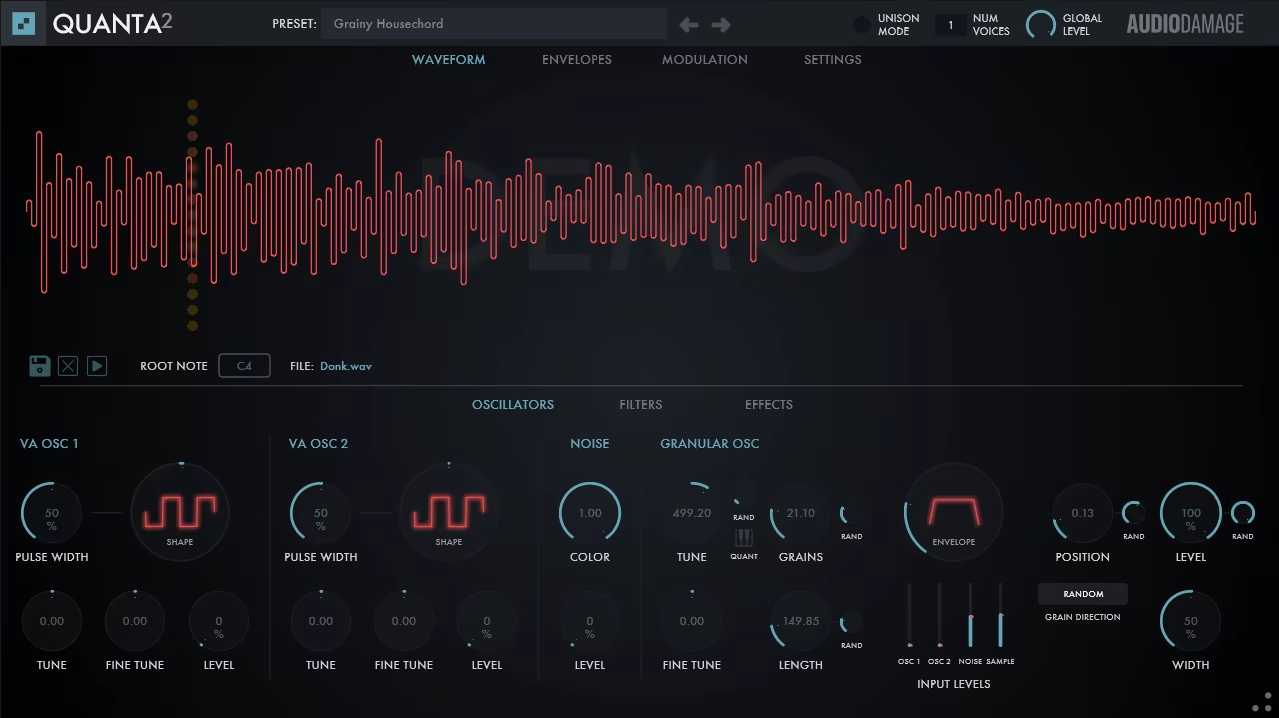
Quanta 2 is a granular synth VST plugin that lets you load samples, slice them into tiny grains, and sculpt them into shimmering textures, glitchy rhythms, or lush atmospheres, and that too with a lot of flexibility.
What I liked most about Quanta 2 is the interface, as it consists of 2 virtual analog oscillators, and you’ve also got a built-in effects section with chorus, delay, and reverb to add polish or space to your creations. Y
ou can shape them with pulse width, fine-tuning, and even a sub-oscillator to add weight to your patches.
Layer these with the granular oscillator, and you’ve got a hybrid synth capable of everything from thick, warm basses to shimmering, ethereal leads.
- Highly Functional Granular Workflow
The new updates on the plugin have increased utility with features like root note detection for your samples. Quanta 2 automatically identifies the pitch of the sample you load and adjusts it to play nicely with the virtual oscillators.
Its granular engine itself is also a playground wherein you can control the grain position, length, and density and even randomize them for added unpredictability. Turn the grain length down, and you get stuttery, glitchy textures. Crank it up, and your sound transforms into a dreamy cloud of audio particles.
Add a little pitch randomization, and you’re swimming in a sea of sparkling grains. It’s the kind of tool that makes you lose hours just exploring what’s possible.
- Modulation Capabilities
Quanta 2 is packed with function generators, envelopes with breakpoints and looping options, and two LFOs with variable shapes.
All of these can be synced to your DAW or set to free-run, and they can modulate just about anything. Want to map aftertouch to grain density or the mod wheel to pitch? Easy. You can even set up rhythmic, time-synced modulations that turn your sound into a constantly evolving texture.
Lastly, the star here for me is the effects section. You’ve got a reverb that can turn your patches into cavernous soundscapes, a delay for rhythmic echoes, and a chorus to add width and movement.
Audio Damage Quanta 2 is available in CLAP, VST3, AAX, AU, and LV2 plugin formats and is compatible with Linux, Ubuntu 20 or later, Windows 10 or newer, and Mac OS 10.14 or higher operating systems.
5. Cymatics DARK SKY
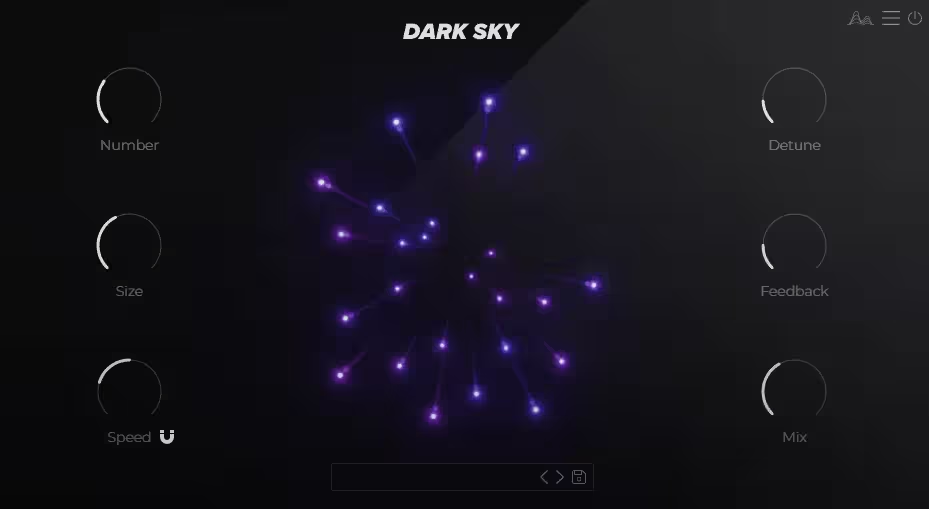
The first thing that hooked me about Dark Sky is how intuitive it is.
What makes Dark Sky so special for me is its balance with intuitive design and flexibility. I’ve thrown just about everything at it, guitars, pianos, vocals, drums, and it always finds a way to elevate the sound.
One time, I took a super dry guitar loop, dialed up the grain count, added some detune, and set the speed to half-time. What came out was this haunting, cinematic texture that completely changed the vibe of my track.
- Easy Controls & Workflow
You’ve got 6 controls: Number, Size, Speed, Detune, Feedback, and Mix, and all are quite easy to understand. The Number knob determines how many grains are generated, so you can go from sparse, glitchy echoes to dense, reverb-like textures in seconds.
The Size control lets you adjust the length of those grains, giving you either sharp, choppy effects or smooth, flowing atmospheres.
Then there’s Speed, which acts as both a pitch shifter and playback control. Dropping the speed down creates these dark, brooding tones, while cranking it up gives the sound a bright, almost hyperpop-like shimmer.
The Detune knob adds subtle pitch variation between the grains and is like a built-in chorus effect that makes everything feel warm and dreamy. And the Feedback control recycles grains back into the effect, creating these infinite, evolving soundscapes that feel like they could go on forever.
The Mix knob also ties it all together, letting you blend the processed signal with the original audio for just the right amount of texture.
- Simplified GUI
I consider the simplicity of the interface to be another huge win. The visualizer shows exactly how the grains are being generated and manipulated, so I can see what’s happening to the sound in real-time.
One trick I love is setting the Speed to double-time for an energetic, almost stuttered effect, then cranking up the Feedback and blending it with the dry signal. The result is this sparkling, rhythmic texture that fills the mix beautifully.
Cymatics Dark Sky is available in VST3, AU, and AAX plugin formats and is compatible with both Windows and Mac operating systems.
6. Imaginando FRMS
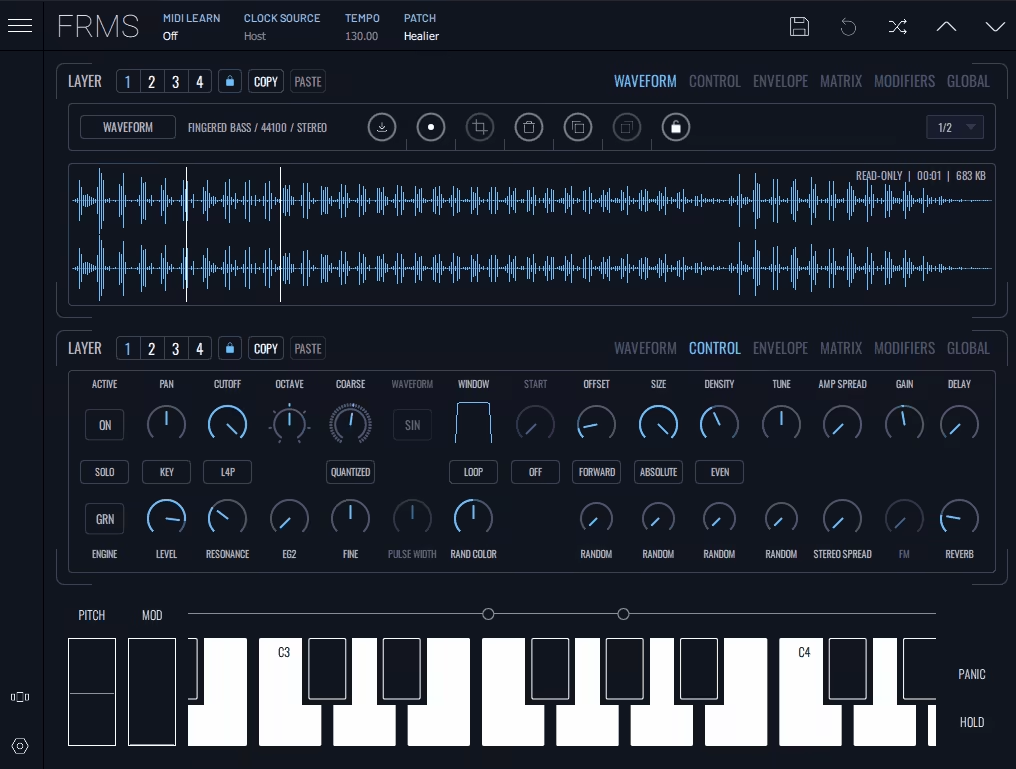
FRMS takes things up a notch by combining granular synthesis, FM synthesis, and subtractive synthesis, letting you stack and blend up to four layers of sound per voice.
At its core, FRMS is all about layering. Each of the 4 layers can be set to granular mode, FM, or subtractive synthesis, giving you an incredible range of creative freedom.
When I want a lush ambient pad with a sprinkle of granular sparkle or a chaotic, evolving soundscape with FM bite, FRMS can make that happen brilliantly.
- Deep Sound Sources
Each layer can generate up to 20 grains per voice, and with 8 voices of polyphony, you can create massive, evolving textures that push the boundaries of what’s possible with sound design. I love the power of this granular synth plugin as it allows me to get deep in sound design.
You can load up one of the high-quality samples included in the library, drop in your own audio, or even use live input to generate grains in real-time. Imagine recording a live guitar performance and instantly transforming it into a dreamy, evolving pad or glitchy mechanical textures, but it’s all possible with FRMS.
- Straightforward Interface
FRMS splits the view between layers, making it super simple to switch between them and tweak every parameter. Each layer has its own modulation matrix, filter, and envelope generators, giving you precise control over the sound.
And with 8 FM modes, you can use layers as FM operators to create complex harmonic relationships that would make any sound designer’s heart race.
- Modulation Options
You’ve got 4 LFOs with 6 modes, a powerful arpeggiator with 5 patterns, and modulation matrices for each layer. Whether I’m creating slow, evolving drones or fast, rhythmic sequences, the modulation tools make it easy to add movement and complexity.
To top it all off, FRMS includes delay and reverb effects, which can be added per layer for even more depth and atmosphere.
The synth is also fully MPE-compatible, so if you’ve got a MIDI Polyphonic Expression controller, FRMS will respond beautifully to every nuance of your performance. It even supports Ableton Link, making it a seamless addition to any live or studio setup.
Imaginando FRMS is compatible with Mac OS 11.0 or higher and Windows 10 or higher operating systems and is available in AAX, AU, and VST plugin formats.
7. Sound Particles Density
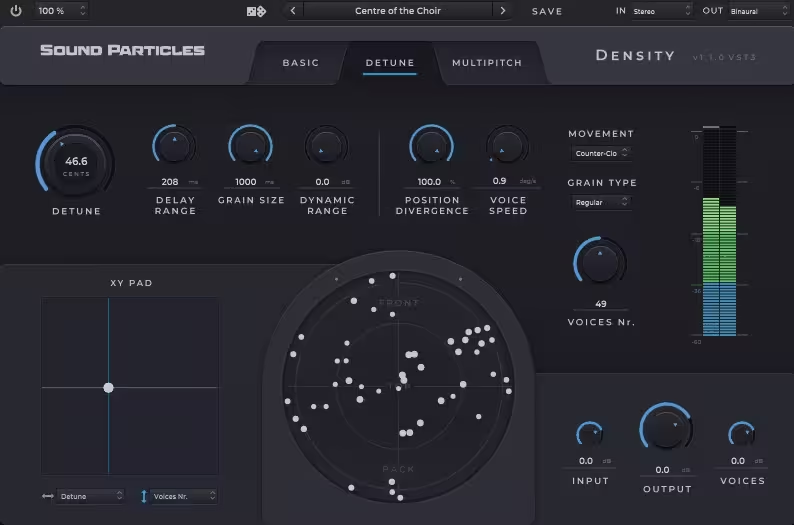
If you’ve ever wanted to turn a single sound into a lush, sprawling ensemble, Sound Particles Density could be your new best friend.
As a granular VST effect plugin, Density has 3 primary modes. The Basic Mode is perfect for rapid outcomes, with just a few controls, allowing you to create large or small ensembles with ease. It’s ideal for when you need results fast without diving too deep.
Then there’s Detune Mode, which gives you more control over the movement and variation of your layers, letting you create subtle shifts and rich, chorusing effects. I think this is where the plugin shines with many controls and possibilities.
Finally, the Pitch Mode takes things to another level, letting you build harmonized layers with independent pitch and number of voices and gain control.
- Interactive and Friendly Workflow
One of my favorite features in Density is the XY Pad, which allows you to control two parameters simultaneously with your mouse.
It’s perfect for live tweaking and adding expressive motion to your sound. There’s also a Top View visualizer, which shows your layers arranged in a 3D space, making it easy to understand and control their spatial placement. Combine that with movement patterns for the grains, and your sounds become dynamic and full of life.
For those who love to experiment, the randomization tools are a dream. You can load up presets or hit the randomize button to instantly generate out-of-the-box results. It’s great for breaking out of creative ruts or discovering new ideas you wouldn’t have thought of otherwise.
- Dolby Mixing
And let me talk about the sheer flexibility of formats. Density supports everything from stereo to 5.1, 7.1, and even Dolby Atmos. Whether you’re mixing a standard track or creating immersive audio for film, this plugin has you covered.
Besides, having this feature for a granular effect is really a rare occurrence and a treat for sound designers.
Sound Particles Density is available in AAX Native, AUv2/v3, and VST3 plugin formats and is compatible with Mac OSX 10.15 or higher and Windows 10 or higher operating systems.
8. Imagiro Autochroma
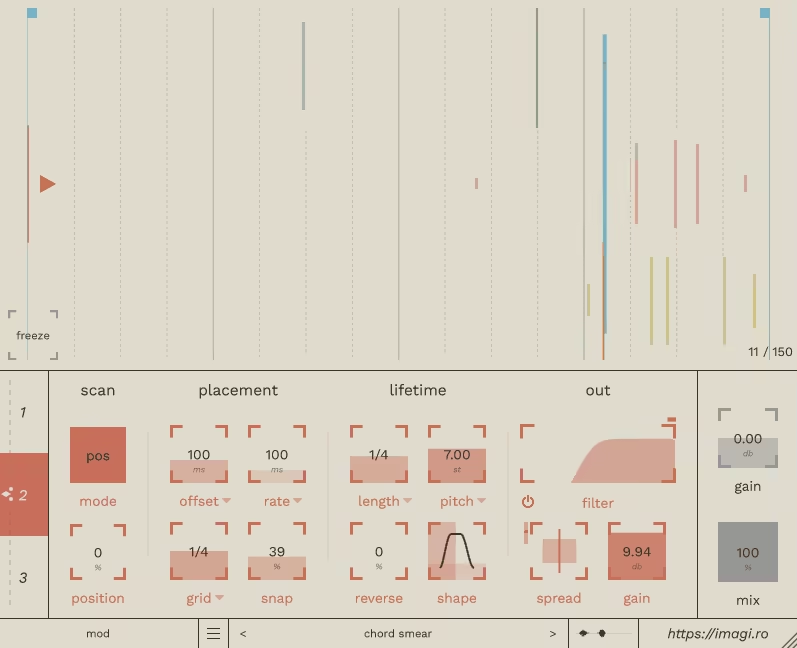
If you’ve ever been intimidated by granular FX plugins, let me introduce you to Autochroma, a granulizer that’s all about fun, creativity, and ease of use.
Unlike many granular processors that can feel like you’re wrestling with a math problem, Autochroma is built to inspire experimentation without the stress.
With its playful interface, rolling buffer, and three simultaneous grain streams, it turns even simple audio into vibrant, evolving textures.
- Simplified Granular Workflow
For me, what makes Autochroma unique is how effortlessly it handles complexity.
Essentially, it works by continuously capturing live audio (or loaded audio files) into a rolling buffer. Each of its 3-grain streams scans through this buffer to pull out little snippets of sound, called grains, and shape them into something entirely new.
Whether I want lush harmonies, glitchy chaos, or subtle texture, Autochroma delivers without making you work too hard.
I found the controls to be really straightforward but powerful. I can adjust grain rate, length, and shape, as well as their pitch and spread, to fine-tune how the grains behave.
Autochroma doesn’t limit itself to traditional granular sounds, either. It can be a drum thickener, wow filter, radio effect, chorus, or even a reverb. With its large preset library, you can dive into ideas like turning a room reverb into a pulsing, fragmented space or creating cacophonous harmonies that dance across your stereo field.
- Modulation System
This lets me bring your sounds to life with movement and unpredictability. Autochroma has four highly customizable modulators, including LFOs, envelopes, and macros. You can assign these to nearly any parameter, whether it’s grain pitch, length, or spread.
For example, you can use an LFO to introduce a subtle pitch wobble, making the grains feel more organic, or modulate the size of the grains to create dynamic shifts in the texture. The modulation panel is simple to use but adds layers of depth to your sound design.
- Rolling Buffer
The rolling buffer is a feature I really appreciate, as it captures the last 30 seconds of audio. You can save it with a single click without worrying about recreating it. You can focus on exploring rather than trying to remember every tweak you made.
I think the versatility of Autochroma is astounding. It’s perfect for turning dry sounds into rich, textured atmospheres, but it can also create gritty, noisy effects reminiscent of old radios or downsampled digital artifacts.
By combining multiple-grain streams with filters and modulation, you can build anything from intricate soundscapes to abstract, glitchy chaos. For beginners, this is the best granular effect tool you can find.
Imagiro Autochroma is available in AAX, AU, VST3, and standalone plugin formats and is compatible with Mac OSX 10.15 or higher and Windows 10 or higher operating systems.
9. Dawesome Novum
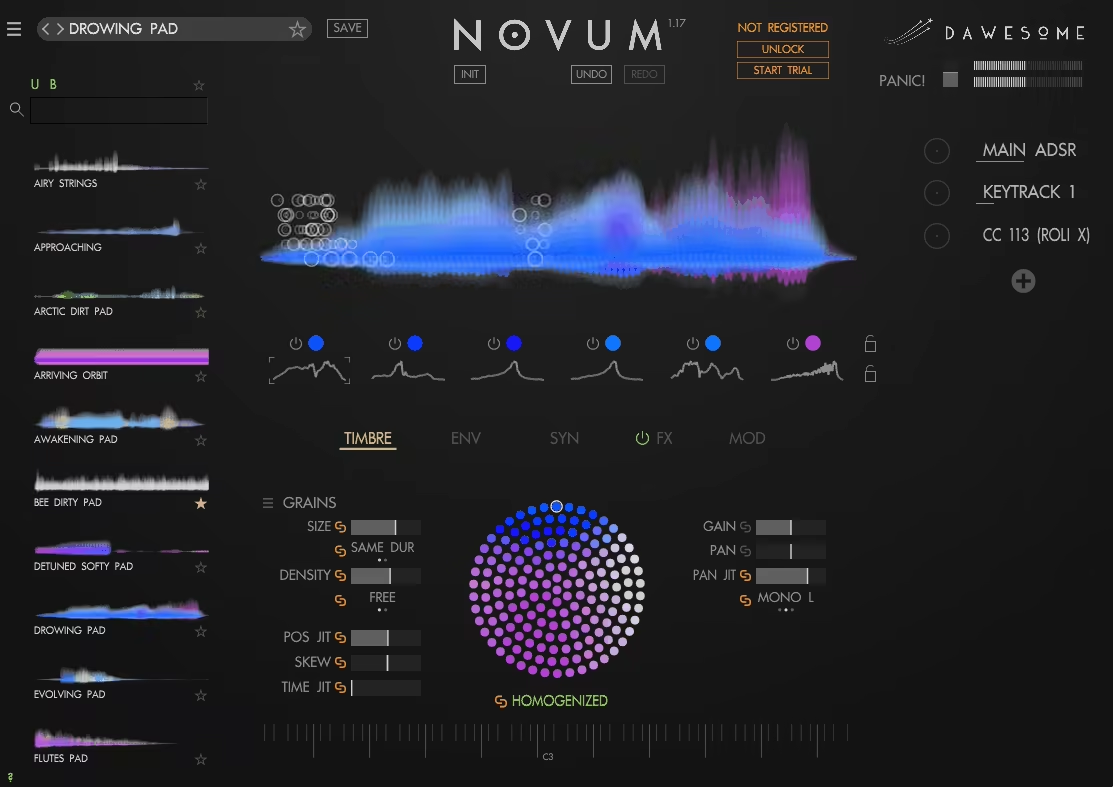
If you’ve ever wanted to break a sound into its fundamental elements and rebuild it into something completely new, Dawesome Novum is a game-changer. This granular synth plugin sounds as good as it looks.
From shimmering pads to chaotic soundscapes, Novum is like having a fully customizable instrument built from the DNA of your audio. At the heart of Novum is its decomposition engine, which splits a sample into six independent layers. Imagine peeling apart a sound’s timbre and temporal dynamics and then manipulating each layer separately.
You can create entirely new tones, textures, and movements, all from a single sound. And, wait for it, the timbre flower takes this even further, allowing you to morph and reshape the character of each layer into something lush, noisy, synthetic, or anything in between.
- Cross-synthesis
With a simple drag-and-drop, I love that you can easily blend the qualities of different sounds.
Think flute with the timbre of a piano or a bell sound with the sweeping dynamics of a filter. Lock the timbre and envelope, and you can instantly browse through presets to generate countless variations of your original sample.
- Easy Editing
Of course, Novum also boasts a granular engine that goes beyond traditional synthesis. You can tweak grain size, density, and pitch independently or sync grains to your DAW’s tempo for rhythmic effects.
And the HOMOGENIZE feature smooths textures into velvety, cohesive tones that feel larger than life, which I enjoy working with for ambient sounds. All in all, I think this is a pretty handy plugin for experimental and sound design.
Dawesome Novum is available in AAX, AU, VST3, and standalone plugin formats and is compatible with Mac OS 10.13 or higher and Windows 10 or higher operating systems.
10. Output Portal
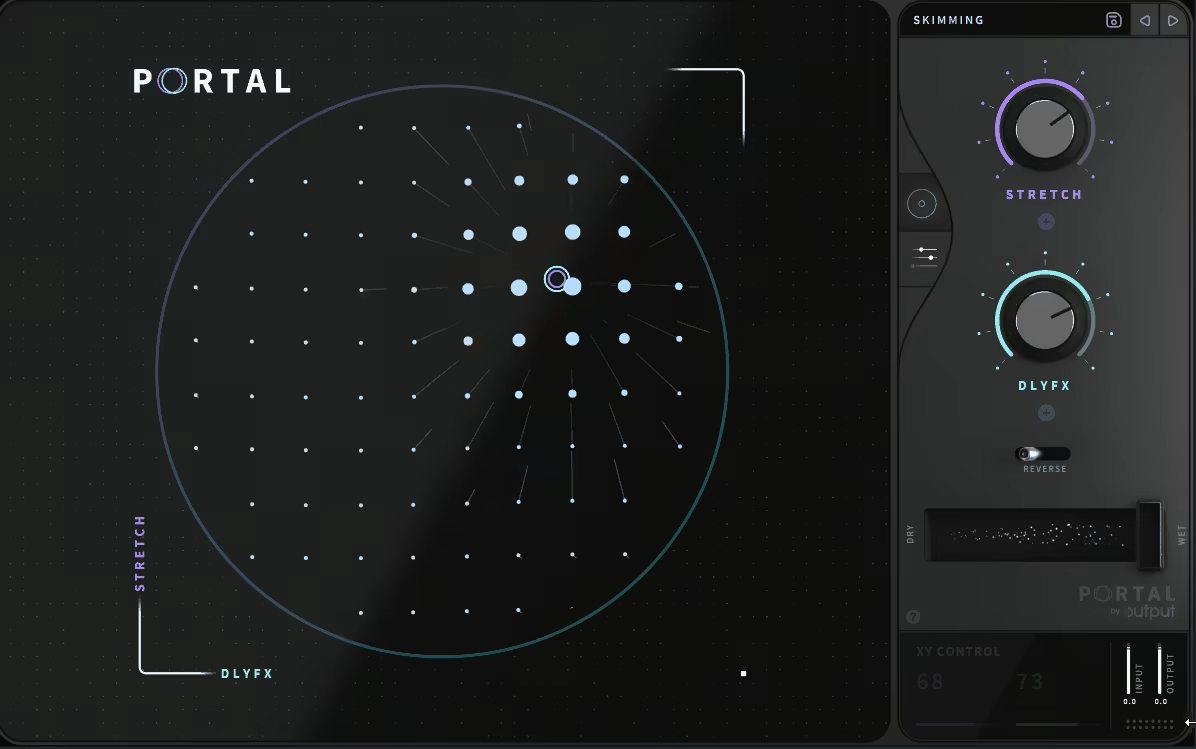
Granular synthesis has a reputation for being abstract and chaotic, but Portal flips that idea on its head.
This plugin takes the tiny grains of your audio, reshapes them, and spits out something entirely new yet still grounded in your music.
What I love most about Output Portal is how accessible it is. Its main page features an intuitive circular XY control, which lets you manipulate multiple parameters in real time.
- Ease of use
This, combined with the Dry/Wet knob and Reverse control, makes it easy to dive in and start tweaking right away. And if you’re not sure where to start, Portal’s 250+ presets offer instant inspiration. Each preset has its own vibe, from subtle atmospheric touches to mind-bending stutters and textures.
- Advanced Page
When you dig into the Advanced Page of Portal, that’s where the real magic happens.
I appreciate that you can control grain speed, density, size, and pitch, all while syncing them to your DAW’s tempo for perfectly rhythmic effects. Its Re-trigger knob shifts the playhead of your audio, adding unique rhythmic variations, and the Scale-based pitch modulation ensures everything stays harmonically relevant.
Another advantage I found was that Portal also comes loaded with effects like bit reduction, distortion, reverb, and delay, which can all be modulated for dynamic results.
Output Portal is available in AAX, AU, and VST2/3 plugin formats and is compatible with Mac OS X 10.14 to macOS 13 Ventura and Windows 10 or higher operating systems.
11. Sugar Bytes Graindad
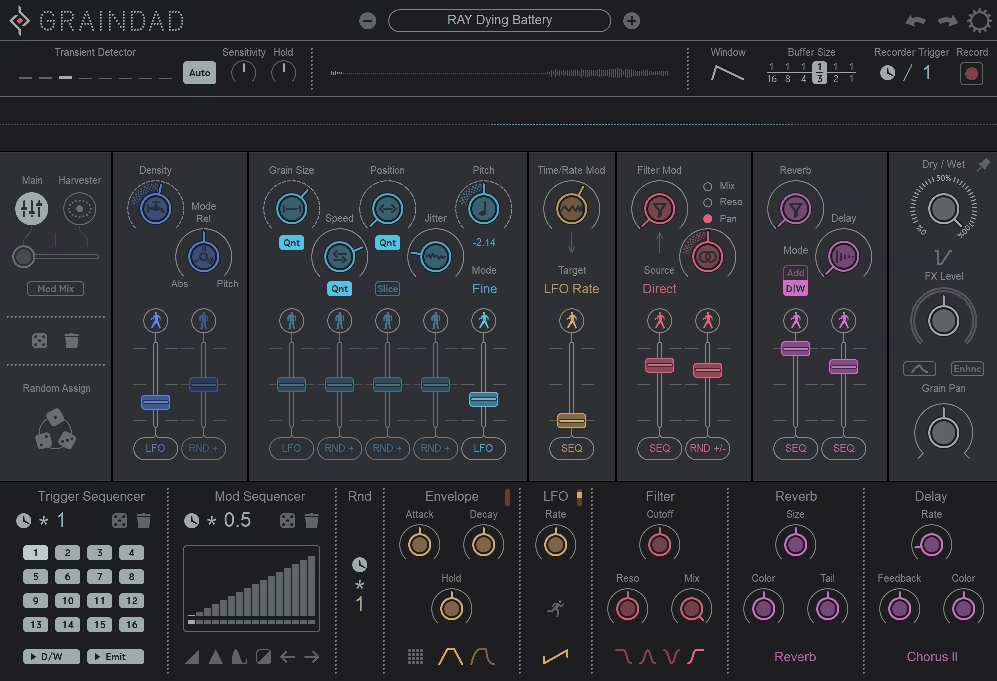
Graindad doesn’t just give you granular processing and gives you granular storytelling.
With Graindad‘s highly customizable grain engine, you can control density, pitch, speed, jitter, and even randomization to shape your sound exactly how you want it.
You can work with up to 64 grains with 12 different controllers for editing those grains. I particularly felt the excitement with its modulation system, though.
- The Harvester: A Modulation Monster
The plugin’s modulation system lets me map out the movement of my grains in real time and can modulate its 12 controls all at once.
I can literally draw paths for your grains to follow, and the effect changes as they traverse these different points. I have never used another plugin that lets you create these granular effects in such an interactive and engaging way.
- Versatile Sound Design
Graindad comes packed with hundreds of presets that range from delicate ambient washes to aggressive, time-warping distortions. You can dial in anything from subtle reverbs to complete audio deconstruction. This granular effect plugin also offers an intuitive XY control for real-time performance tweaks, making it an absolute joy for live manipulation.
Sugar Bytes Graindad is available in AAX, AU, and VST2/3 plugin formats and is compatible with Mac OS X 10.13 or higher and Windows 10 or higher operating systems.
12. Sinevibes Albedo
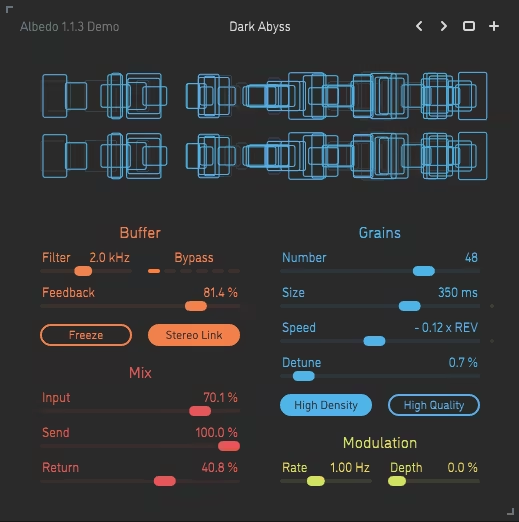
Albedo is one of the best granular effects plugins based on granular processing of the sound, called granular cloud.
Albedo continuously records incoming audio into a circular buffer while layering up to 64 independent looping grains over it. Each grain has its own randomized position and size, which, when blended together, creates a vast and immersive “cloud” effect.
Whether you’re looking to add a shimmering, celestial touch or completely dissolve a sound into ambient oblivion, Albedo’s got you covered.
- Fluid Motion
Albedo transitions seamlessly between forward and reverse playback. Unlike many granular effects that can feel rigid or static, Albedo enables smooth, tape-like manipulation, allowing you to slow, stop, and even reverse grains in real time without any jarring artifacts.
- Endless Possibilities
I think Albedo isn’t just for dreamy ambient washes, as with its built-in multi-mode filter, synchronized modulation options, and stereo link functionality, it allows you to use it for everything from evolving pitch shifts to chaotic, reversed delays and even eerie, dissonant atmospheres.
You can also freeze the buffer indefinitely, letting you create evolving soundscapes that blend perfectly with your live input.
- Designed for Performance
Beyond its sonic capabilities, Albedo is built with performance in mind. Its color-coded, highly responsive interface makes it easy to tweak parameters on the fly, while the built-in preset manager lets you recall your favorite settings instantly. I like the balance of ease of use and functionality, which makes this unit beginner as well as pro-friendly.
Whether you’re sculpting ethereal reverbs or crafting otherworldly sound layers, this plugin is intuitive and inspiring.
Sinevibes Albedo is available in AAX, AU, and VST2/3 plugin formats and is compatible with Mac OS X 10.9 or higher and Windows 8 or higher operating systems.
What is Granular Synthesis Good For?
You can use granular synthesis to create "grainy" textures, time and space-based effects, evolving pads, atmospheric soundscapes, or just experiment to see what unique you can get out of it. It excels in time-stretching, pitch-shifting, and generating glitchy, fragmented effects.
What does Granular Synthesis Sound Like?
Granular synthesis can produce everything from shimmering, reverb-like clouds to harsh, glitchy distortions. It can stretch a sound into an infinite drone, turn a vocal into a ghostly choir, or break a drum loop into rhythmic chaos. Depending on grain size, density, and modulation, it can sound smooth and atmospheric or chaotic and fractured.


